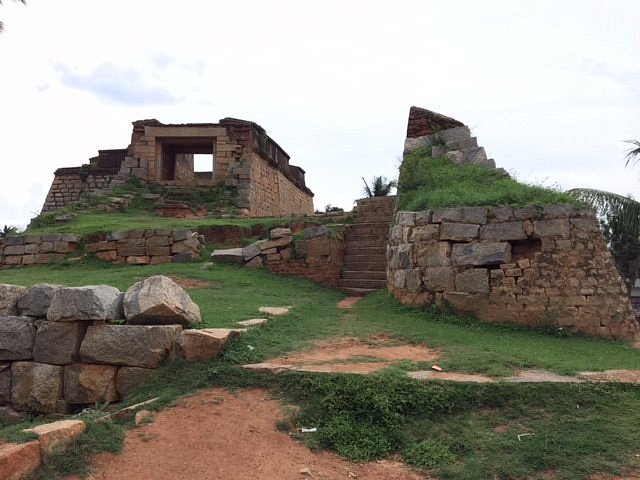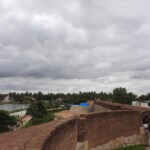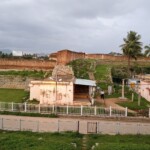
Approximately 35 kilometers northeast of Bangalore lies the historic Devanahalli Fort. Constructed during the first half of the 16th century, it stands as one of India’s most renowned tourist destinations. What sets Devanahalli Fort apart from others across the country is its remarkable architecture and the tales of battles it witnessed throughout its history.
This fort was erected by the Gowda family, who made it their residence for many decades. Even today, visitors can explore the ancient ruins of houses that have withstood the test of time. Situated in close proximity to Bangalore, the fort holds immense cultural significance, having served as the backdrop for numerous pivotal battles.
Spanning an impressive 20-acre expanse, Devanahalli Fort ranks among India’s largest and most architecturally captivating forts. Thanks to its rich historical heritage, it draws visitors from all corners of India and beyond.
Interestingly, it’s situated near the birthplace of Tipu Sultan, renowned as ‘the tiger of Mysore.’ Within the fort’s precincts, numerous temples add to its allure. The walls of the fort bear witness to the battles fought here, their stories etched in graffiti, making this ancient stronghold a true marvel of its kind.
Speaking of the temples within the fort, several are dedicated to local deities. Prominent among them are the Siddheswar Swami Temple, Chandramouleshwara Temple, and Raghavendra Swamy Temple.
Though some minor damage occurred to these temples during various battles in the fort’s history, they were painstakingly restored over time. Today, they serve as a hub for tourists from all over India and abroad, offering a glimpse into the fort’s enduring legacy.
Devanahalli Fort Timing
The temples within Devanahalli Fort are open to the public during the following hours:
-
- Morning: 7:00 AM to 1:00 PM
- Evening: 6:00 PM to 8:00 PM
Please note that these timings specifically apply to the temples within the fort, and the fort itself may have its visiting hours that could differ. It’s always a good idea to verify the opening hours for both the fort and the temples before planning your visit, as they can occasionally change due to various factors.
Dodda Ganapathi Temple Bengaluru Timings, Entry Ticket Fee, History
History of Devanahalli Fort Bangalore:
The history of Devanahalli Fort is rich and storied, dating back to the first half of the 16th century. Here is a concise account of its historical journey:
Devanahalli Fort, located approximately 35 kilometers northeast of Bangalore, Karnataka, India, has a history that intertwines with the rise and fall of various dynasties and rulers. It is believed to have been built in 1501 by Mallabairegowda, a chieftain under the Vijayanagara Empire, making it over five centuries old.
Over the years, the fort changed hands several times, witnessing a series of battles and conflicts. In the late 17th century, it fell into the hands of the Wodeyar kings of Mysore, and later, it was conquered by Hyder Ali, the father of Tipu Sultan, in the mid-18th century.
The fort gained significant historical prominence when it became the birthplace of Tipu Sultan, who later became known as ‘the tiger of Mysore.’ Tipu Sultan and his father Hyder Ali used Devanahalli Fort as a strategic military outpost during their reign.
In the late 18th century, during the Anglo-Mysore Wars, the fort witnessed a series of battles between the British East India Company and Tipu Sultan’s forces. It was eventually captured by the British in 1791 and played a pivotal role in their campaign against Tipu Sultan.
Post-independence, the fort lost its military significance but remained a symbol of historical and architectural importance. Today, it stands as a testament to the centuries of history it has endured, with its well-preserved architecture, ancient temples, and the echoes of battles that once raged within its walls.
Devanahalli Fort has evolved from a strategic stronghold to a popular tourist destination, attracting history enthusiasts, architecture aficionados, and visitors eager to explore its captivating past. Its enduring legacy continues to fascinate and educate those who venture within its time-honored confines.
Images of Devanahalli Fort Bangalore
Devanahalli Fort Entry Fee
As of my last knowledge update in September 2022, Devanahalli Fort in Bangalore did not typically charge an entry fee for visitors. It was open to the public, and you could explore the fort and its premises without any admission fee. However, please note that circumstances and policies can change over time.
To ensure the most up-to-date information regarding entry fees and any other specific details about visiting Devanahalli Fort, I recommend checking with the local authorities or conducting an online search closer to your intended visit date. It’s possible that there may have been developments or changes since my last update.
Architecture of Devanahalli Fort Bangalore
The architecture of Devanahalli Fort in Bangalore is a remarkable testament to the craftsmanship and strategic design of its time. Here’s an overview of its architectural features:
- Entrance and Fortification: The fort is enclosed by sturdy stone walls with impressive battlements and bastions, showcasing a mix of Hindu and Islamic architectural influences. The main entrance features a massive gateway, known as the ‘Delhi Gate,’ adorned with intricate carvings and decorative elements.
- Moat and Drawbridge: Surrounding the fort, a wide moat was dug as an additional defense measure. Originally, a drawbridge spanned the moat, adding to the fort’s security.
- Bastions and Watchtowers: Devanahalli Fort boasts several bastions and watchtowers strategically positioned along its walls. These were not only used for defense but also served as vantage points for overseeing the surrounding terrain.
- Temples: Within the fort complex, you’ll find several ancient temples, each with its unique architectural style. Prominent among them are the Siddheswar Swami Temple, Chandramouleshwara Temple, and Raghavendra Swamy Temple. These temples showcase exquisite stone carvings and sculptures.
- Living Quarters: The fort was once a bustling residential area, and remnants of age-old houses can still be seen today. These houses, though in ruins, provide insights into the architectural styles and living conditions of the past.
- Fortresses and Strongholds: The fort contains several internal fortresses and strongholds, reinforcing its defensive capabilities. These structures were designed to withstand attacks and prolonged sieges.
- Architectural Fusion: One of the most intriguing aspects of Devanahalli Fort’s architecture is its blend of different architectural styles. It reflects a fusion of Dravidian, Indo-Islamic, and Vijayanagara architectural influences, owing to the various rulers who occupied and modified the fort over the centuries.
- Graffiti and Inscriptions: The fort walls feature graffiti and inscriptions that offer a glimpse into its historical significance and the events that unfolded within its walls. These markings tell the tales of battles, conquests, and the passage of time.
- Restoration Efforts: Over the years, efforts have been made to preserve and restore the fort’s architectural heritage. These endeavors have ensured that the fort continues to stand as a remarkable example of medieval South Indian fort architecture.
Devanahalli Fort’s architectural grandeur, coupled with its historical significance, makes it a captivating destination for history buffs, architecture enthusiasts, and tourists seeking to immerse themselves in the rich heritage of the region.
Places to visit near Devanahalli Fort Bangalore
The architecture of Devanahalli Fort in Bangalore is a remarkable testament to the craftsmanship and strategic design of its time.
Here’s an overview of its architectural features:
Entrance and Fortification:
The fort is enclosed by sturdy stone walls with impressive battlements and bastions, showcasing a mix of Hindu and Islamic architectural influences. The main entrance features a massive gateway, known as the ‘Delhi Gate,’ adorned with intricate carvings and decorative elements.
Moat and Drawbridge:
Surrounding the fort, a wide moat was dug as an additional defense measure. Originally, a drawbridge spanned the moat, adding to the fort’s security.
Bastions and Watchtowers: Devanahalli Fort boasts several bastions and watchtowers strategically positioned along its walls. These were not only used for defense but also served as vantage points for overseeing the surrounding terrain.
Temples:
Within the fort complex, you’ll find several ancient temples, each with its unique architectural style. Prominent among them are the Siddheswar Swami Temple, Chandramouleshwara Temple, and Raghavendra Swamy Temple. These temples showcase exquisite stone carvings and sculptures.
Living Quarters:
The fort was once a bustling residential area, and remnants of age-old houses can still be seen today. These houses, though in ruins, provide insights into the architectural styles and living conditions of the past.
Fortresses and Strongholds:
The fort contains several internal fortresses and strongholds, reinforcing its defensive capabilities. These structures were designed to withstand attacks and prolonged sieges.
Architectural Fusion:
One of the most intriguing aspects of Devanahalli Fort’s architecture is its blend of different architectural styles. It reflects a fusion of Dravidian, Indo-Islamic, and Vijayanagara architectural influences, owing to the various rulers who occupied and modified the fort over the centuries.
Graffiti and Inscriptions:
The fort walls feature graffiti and inscriptions that offer a glimpse into its historical significance and the events that unfolded within its walls. These markings tell the tales of battles, conquests, and the passage of time.
Restoration Efforts:
Over the years, efforts have been made to preserve and restore the fort’s architectural heritage. These endeavors have ensured that the fort continues to stand as a remarkable example of medieval South Indian fort architecture.
Devanahalli Fort’s architectural grandeur, coupled with its historical significance, makes it a captivating destination for history buffs, architecture enthusiasts, and tourists seeking to immerse themselves in the rich heritage of the region.
Places to eat near Devanahalli Fort Bangalore
While Devanahalli Fort is a historically rich destination, there are several dining options nearby where you can savor local and regional cuisine. Here are some places to eat near Devanahalli Fort:
Nandi Upachar:
Located close to Nandi Hills, this restaurant offers a range of South Indian and North Indian dishes. It’s known for its delicious breakfast options, including idlis, dosas, and filter coffee.
A2B – Adyar Ananda Bhavan:
A popular chain of vegetarian restaurants, A2B serves a variety of South Indian and North Indian dishes. Their menu includes dosas, vadas, thalis, and sweets.
Kamat Upachar:
Another renowned vegetarian restaurant chain, Kamat Upachar, offers a wide range of South Indian and North Indian delicacies. It’s known for its flavorful thalis and snacks.
Nandi Grand Restaurant:
This restaurant, located in Chikballapur, serves a mix of South Indian and North Indian cuisine. They offer a variety of vegetarian and non-vegetarian options.
Madhura Restaurant:
Situated in Chikballapur, Madhura Restaurant specializes in North Indian and Chinese dishes. It’s a good choice if you’re looking for a different culinary experience.
Hot Chips Restaurant:
Located near Nandi Hills, Hot Chips is a vegetarian restaurant known for its South Indian dishes, including dosas, vadas, and sweets. They also offer a selection of North Indian snacks.
The Green Path Organic State:
If you’re interested in organic and vegetarian cuisine, The Green Path is a great choice. It offers a buffet-style dining experience with a variety of dishes made from organic ingredients.
Local Eateries:
Explore the local eateries and street food stalls in Devanahalli town for a taste of authentic regional flavors. You can find local snacks, chaats, and sweets.
Dhabas:
Along the highways leading to Devanahalli, you might come across some dhabas that serve North Indian cuisine, including delicious rotis, curries, and tandoori dishes.
Hotel Janpath:
Located in Chikballapur, this restaurant offers a range of vegetarian and non-vegetarian dishes. It’s a good spot to try some local Karnataka specialties.
Please note that the availability and quality of these dining options may vary, so it’s a good idea to check reviews or ask locals for recommendations before choosing a place to eat near Devanahalli Fort.
Best Time To Visit Devanahalli Fort
The best time to visit Devanahalli Fort, located near Bangalore, is during the cooler and drier months of the year, which typically fall between October and March. Here’s why this period is considered the ideal time to explore the fort and its surroundings:
- Pleasant Weather: The months from October to March offer pleasant and comfortable weather conditions. The temperatures are milder, with daytime highs ranging from 20°C to 30°C (68°F to 86°F), making it more enjoyable for outdoor exploration.
- Minimal Rainfall: This period experiences lower rainfall, reducing the chances of rain disrupting your visit. Monsoon rains in the preceding months can make the terrain muddy and less accessible.
- Clear Skies: The skies are generally clear during these months, providing excellent visibility for enjoying the scenic views from the fort and nearby Nandi Hills.
- Outdoor Activities: If you plan to engage in outdoor activities such as trekking or exploring the natural beauty around Devanahalli, the cooler weather of the winter months is more suitable for such endeavors.
- Festivals and Events: You might have the opportunity to witness local festivals and cultural events that take place during this time, offering insights into the region’s traditions and heritage.
- Wildlife Sightings: If you’re interested in wildlife, this is a good time for birdwatching and spotting various species in the nearby Nandi Hills area.
While the period between October and March is generally recommended, keep in mind that Devanahalli Fort can be visited year-round. However, visiting during the summer months (April to June) can be quite hot, with temperatures often exceeding 30°C (86°F) and making outdoor exploration less comfortable. Additionally, the monsoon season (July to September) brings heavy rainfall, which may limit outdoor activities and affect road conditions.
To make the most of your visit to Devanahalli Fort and its surroundings, plan your trip during the cooler and drier months to enjoy a more comfortable and memorable experience.
How To Reach Devanahalli Fort Bangalore
Reaching Devanahalli Fort in Bangalore is relatively easy, given its proximity to the city and the well-connected transportation options available. Here’s how you can reach Devanahalli Fort:
By Air:
- Kempegowda International Airport: The nearest major airport to Devanahalli Fort is Kempegowda International Airport (IATA: BLR), located just a few kilometers away. You can take a domestic or international flight to this airport, depending on your point of origin.
By Train:
- Devanahalli Railway Station: Devanahalli has its own railway station, Devanahalli Railway Station (Station Code: DHL), which is well-connected to Bangalore City Junction (KSR Bengaluru City Railway Station) and other major railway stations in Karnataka. You can take a train to Devanahalli and then proceed to the fort by local transport.
By Road:
- From Bangalore City: Devanahalli is approximately 35 kilometers (about 22 miles) from Bangalore city center. You can reach the fort by road via several options:
- Self-Drive: Renting a car or using your own vehicle is a convenient option. You can take NH44 (Bengaluru-Hyderabad Highway) and follow the signs to Devanahalli.
- Taxi/Cab: You can hire a taxi or cab from Bangalore to Devanahalli. Popular ride-sharing services like Uber and Ola also operate in the area.
- Bus: Karnataka State Road Transport Corporation (KSRTC) and private bus operators run regular bus services from Bangalore to Devanahalli. You can catch a bus from the Bangalore Kempegowda Bus Station (Majestic) or other designated bus terminals.
Local Transportation: Once you reach Devanahalli town, you can hire auto-rickshaws or taxis to take you to Devanahalli Fort, which is located in the town itself. The fort is easily accessible within the town limits.
Please note that the availability and frequency of transportation options may vary, so it’s a good idea to check schedules and availability, especially if you’re traveling during peak tourist seasons. Additionally, consider using GPS or navigation apps for convenience in locating Devanahalli Fort from your point of arrival.
Google Map of Devanahalli Fort Bangalore
FAQs of Devanahalli Fort Bangalore
What are the visiting hours of Devanahalli Fort?
Devanahalli Fort generally follows standard visiting hours. However, it's advisable to check the most current timings as they may vary. The temples inside the fort typically have different opening hours.
Is there an entry fee to visit Devanahalli Fort?
As of my last update in September 2021, there was no entry fee to visit Devanahalli Fort. It was open to the public without any admission charge. However, it's recommended to confirm this with local authorities, as policies can change.
What are the nearby attractions to Devanahalli Fort?
Some nearby attractions include Nandi Hills, Nandi Fort, Bhoga Nandeeshwara Temple, and the birthplace of Sir M. Visvesvaraya. These places offer a mix of historical, natural, and cultural experiences.
Can visitors explore the inside of the fort and its surroundings?
Yes, visitors can explore both the fort's interior and its premises. You can wander through the fort's architecture, temples, and historical remnants, as well as enjoy the scenic beauty of the surrounding region.
Are there any specific guidelines or rules for visitors at Devanahalli Fort?
While there are no specific rules mentioned, it's generally advisable to be respectful of the historical site and its surroundings. Visitors should avoid littering, defacing, or causing damage to the fort's structures.
Is photography allowed inside Devanahalli Fort?
Photography is usually allowed inside the fort, but it's a good practice to ask for permission if you plan to photograph individuals, especially at religious sites.
How far is Devanahalli Fort from Bangalore city center?
Devanahalli Fort is approximately 35 kilometers (about 22 miles) northeast of Bangalore city center. The journey can take around an hour, depending on traffic conditions
Is there a good time to visit Devanahalli Fort?
The best time to visit Devanahalli Fort is during the cooler and drier months, typically from October to March, to enjoy pleasant weather and outdoor exploration
Are there any dining options near Devanahalli Fort?
Yes, there are restaurants and eateries in the vicinity of Devanahalli Fort where you can enjoy local and regional cuisine.





